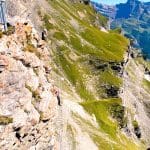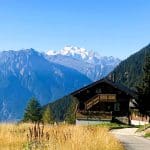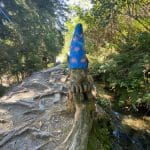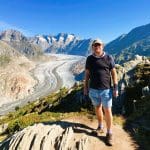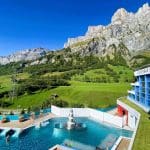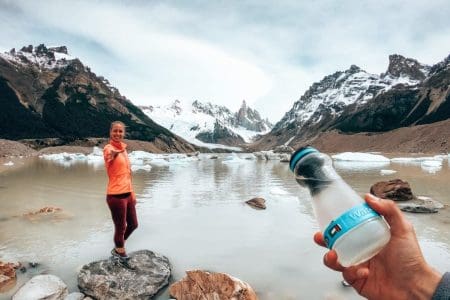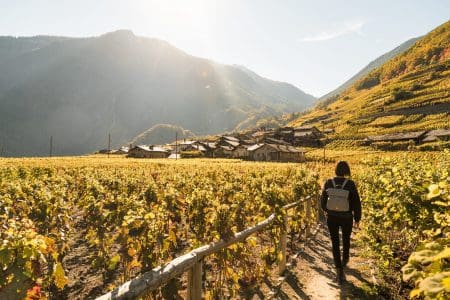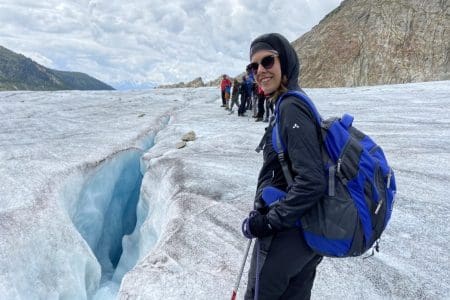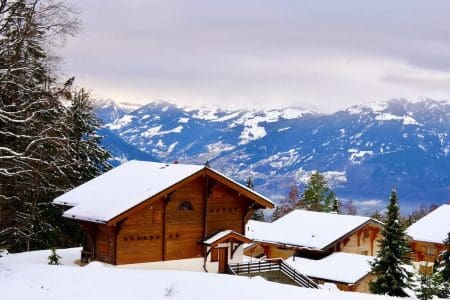Mark Bibby Jackson follows the path of water in Valais Switzerland from the Aletsch Glacier to the bisses at Haute-Nendaz taking in the most spectacular views along the way.
There are views and then there are Views. The panorama in front of me is most definitely the latter. It appears as if the whole of the Alps is laid out in front of me – the Matterhorn is most clear. I have been most fortunate to travel to Switzerland many times in the past few years, but never has it been more spectacular. When asked I always say that being a travel writer is the best job in the world – it is moments like this that make me believe my own words.
We are sitting in the restaurant at Gemmi Lodge at the top of the cable car which provides this birds eye view from the 2,344-metre high Gemmi Mountain across to the snow-capped peaks of the Alps and down to Leukerbad in the valley below. Recently refurbished the restaurant serves excellent rösti accompanied by some healthy salad – ying and yang – and is almost worth the trip up on the cable car alone.
It’s so good that some people seem to be trying to climb their way up to the restaurant although my companion Stefanie Tangeten, from the local tourist department, assures me they are doing some via ferrata – an activity that seems extremely foolhardy to me. Nearby is a lake you can either hike to or take a smaller cable car.
We take the larger cable car back to Leukerbad for my onward journey to Haute-Nendaz.
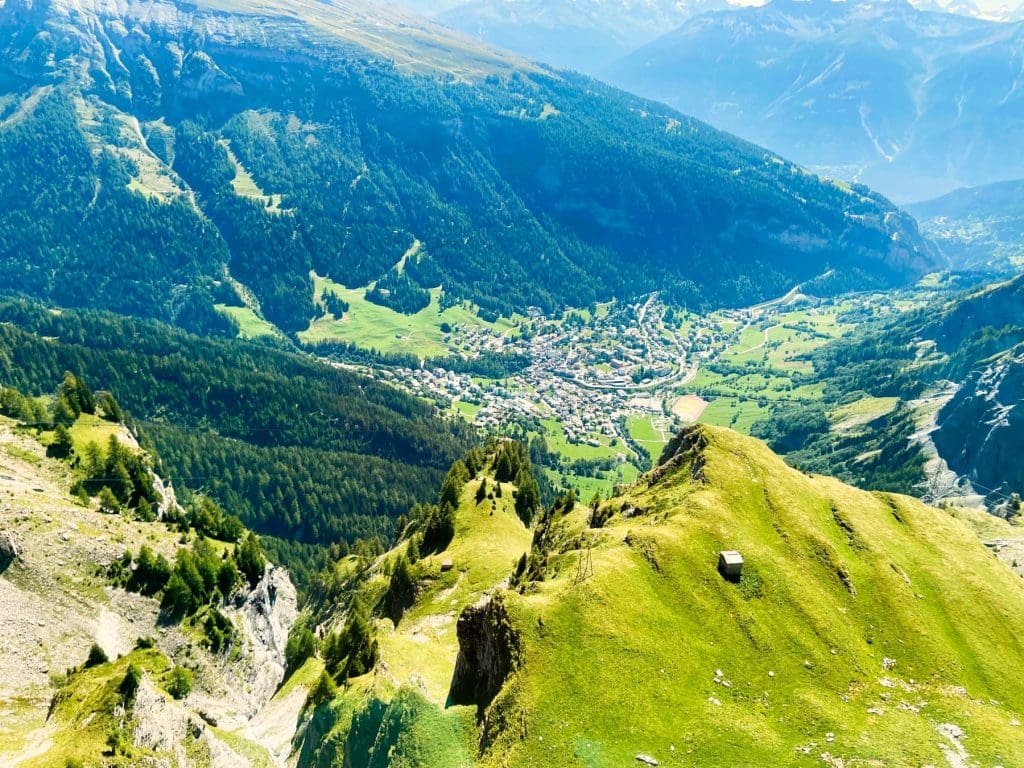
Leukerbad Therme and Canyon Walk
I always think it is the quality of the air that makes Switzerland so special, but on this trip the focus is on water.
Earlier that morning I visit Leukerbad Therme, a major open-air spa with four heated pools. I’m not sure what the difference is between them, but they all have jet streams and the hot spring water that has made this place famous.
The Romans came here in the 2nd century BC, and there has been a thermal culture in Leukerbad or Loeche-Les-bains to give its French name for 500 years. However, the key draw is the spectacular backdrop of the mountains rising from the pastures rather than the healing properties of the water. I emerge feeling very relaxed and am not alone. Judging by the look of my elderly companions the waters must be good for you.
According to Stefanie who proves a font of numerical information, 3.9 litres of thermal water flows into the town every day to 63 springs, with six of them major sources. I first meet her the previous evening when we enjoy a wonderful meal at Restaurant Buljes – the tuna ceviche is incredible. We rendezvous again for a walk along the canyon walkway, which is carved into the side of rock with waterfalls cascading below. Its construction must have been quite some feet of engineering. Closed in winter with repairs carried out in spring, this is an exhilarating but easy walk, so long as you are good with heights.
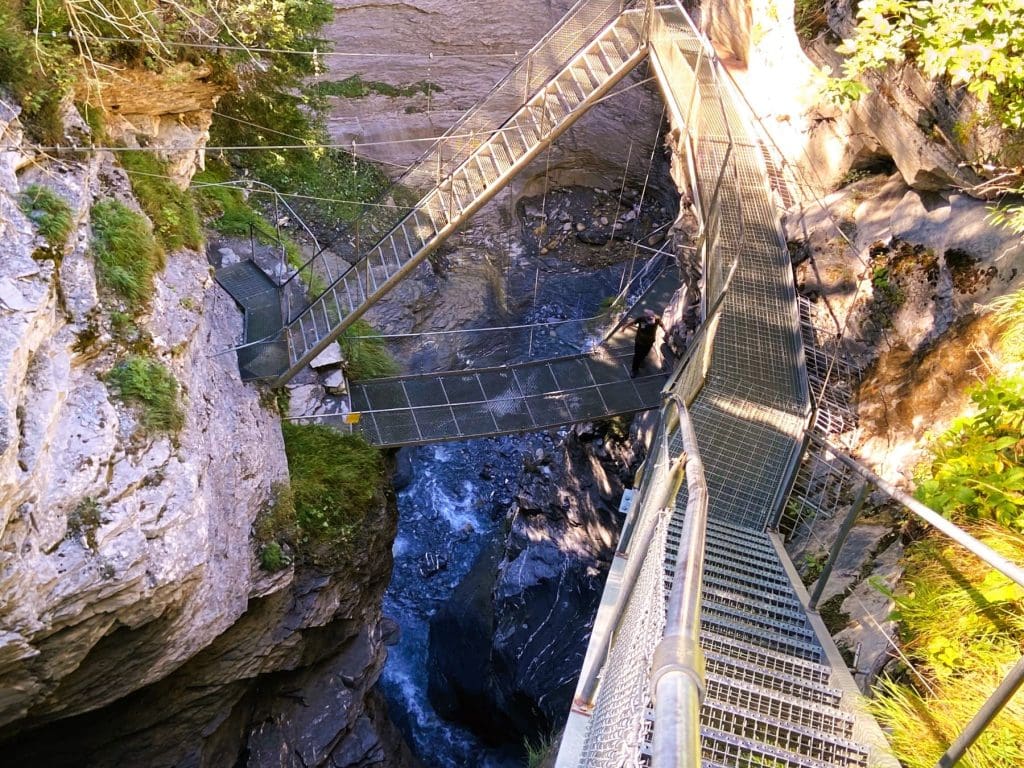
World Nature Forum in Naters
My brief aquatic trip to Switzerland commenced a couple of days earlier in Brig, where I met Jasmine Noti from the Aletsch Arena tourism department. I first encountered Jasmine in 2020, when we went trekking along the Aletsch Glacier. Then, we had been linked together by a rope as we walked along the crackling ice. This time Jasmine escorts me on the much shorter walk from the station to the World Nature Forum in neighbouring Naters.
Here I am given a brief lesson on the flora and fauna in the Aletsch area – there are more than 7,200 types – as well shown models and diagrams of the 20-kilometre long and 800-metre deep Aletsch glacier which is the longest in the Alps.
The museum has lots of educational activities for kids and is designed to make you feel you are climbing out of the valley and into the glacier. It is a sobering thought that 24,000 years ago the whole area was under ice. Shortly prior to my visit, temperatures of 24C were recorded in Aletsch. According to my museum guide Barbara, this is something that has never happened before. She explains that climate change could be particularly severe in the Aletsch Arena with temperatures potentially rising by some 8C. If this were to happen then all the ice will turn to water.
Aletsch Glacier and Moosfluh Geology Walkway
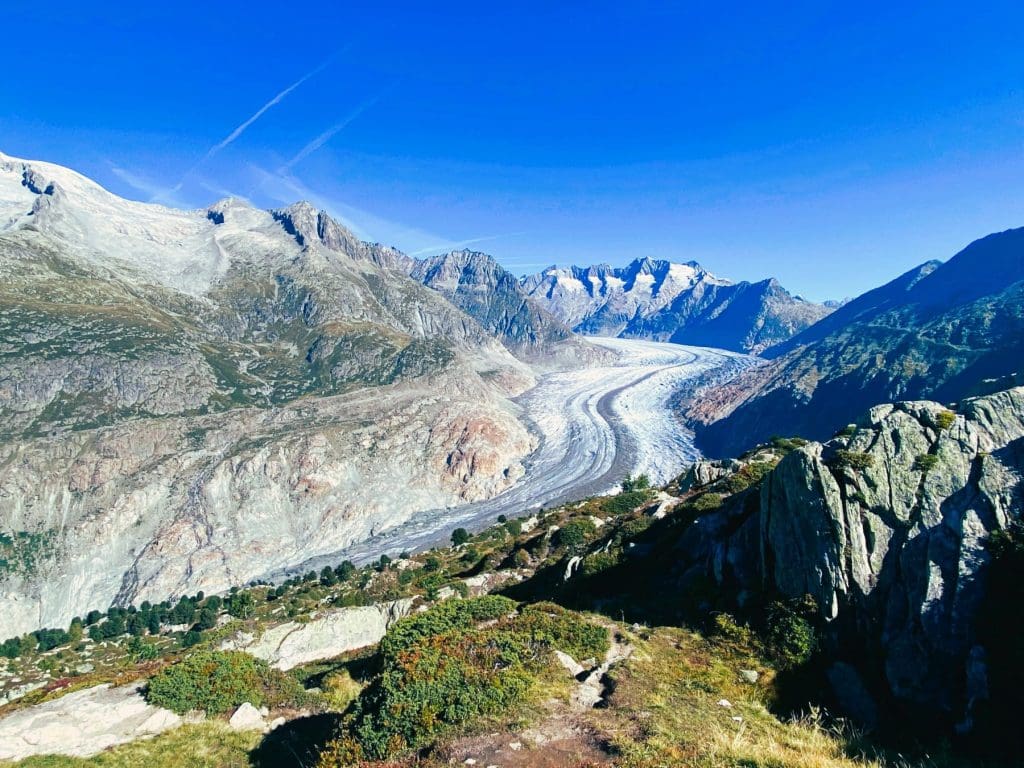
The following day as Jasmine and I take the cable car from the village of Riederalp where I stayed at the charming Golfhotel Riederhof, to the Moosfluh viewpoint, Jasmine explains how the municipality is taking its own measures to try to counteract the negative impact of climate change.
Just like in Saalfelden Leogang, Austria, I visited earlier in the summer, sustainable fuel is used for the cable cars while all public transport is electric. The hotels also use electric cars. Other cars are banned, with visitors leaving their vehicles in towns such as Morel in the valley below and reaching Riederalp via the cable cars.
“We can’t go on about the glacier and not do our own bit,” says Jasmine.
From the Moosfluh viewpoint we look down upon the Aletsch Glacier. It is as spectacular as I remember it. Just out of view around a bend is the Konkordiaplatz, where the Great Aletsch, the Jungfraufirn and Ewigschneefald glaciers meet. The glacier is approximately the same depth as the mountains are high.
On my last visit Jasmine and I descended the slopes to traverse the glacier, this time I am content to take the much more sedate walk along the Moosfluh Geology Walkway, which opened earlier in the summer.
The trail is an easy walk with great educational activities for children that focus on movement. Photographs show how the glacier has shrunk since the 19th century. Apparently, each year the glacier is becoming 115 metres shorter. Around 150 years ago the ice was 400 metres thicker. Even if global temperatures rise by only 2C we will lose 50% of the glacier. Towards the end of the trail, we cross a crevice formed in 2016, reinforcing the message of the peril we all are facing from our foolhardy treatment of nature.
Bettmeralpsee Lake and Bettmerhorn

Fortunately, Jasmine does not allow me to ponder too long on such morbid thoughts. Instead, we take the cable car part way down the mountain to walk to the Bettmerhorn valley station for the ride up to the Bettmerhorn viewpoint. Here, we have more spectacular views of the glacier as well as a hearty lunch of cholera – my favourite Swiss mountain dish, not the fatal disease – at the 2,650-metre high café, followed by a short stroll and a quick visit to the small museum.
On the way we pass the beautiful Lake Bettmersee, where I have the most refreshing swim in the cooling Alpine waters on this glorious sunny day. After all I am supposed to be tracing water, aren’t I?
As this is a rather impromptu stop, I have to change in the nearby toilet block. Judging by its hygiene, the Swiss really do have the cleanest toilets in the world.
The cable car takes us back to the village of Bettmeralp which has the beautiful chapel Mary of the Snow. Fortunately, I have timed my visit for the annual Alpabzug when the cows are led down from high pasture to the church. Cows munch on the grass as children play with the standpipe and the water trough in a picture perfect Swiss landscape.
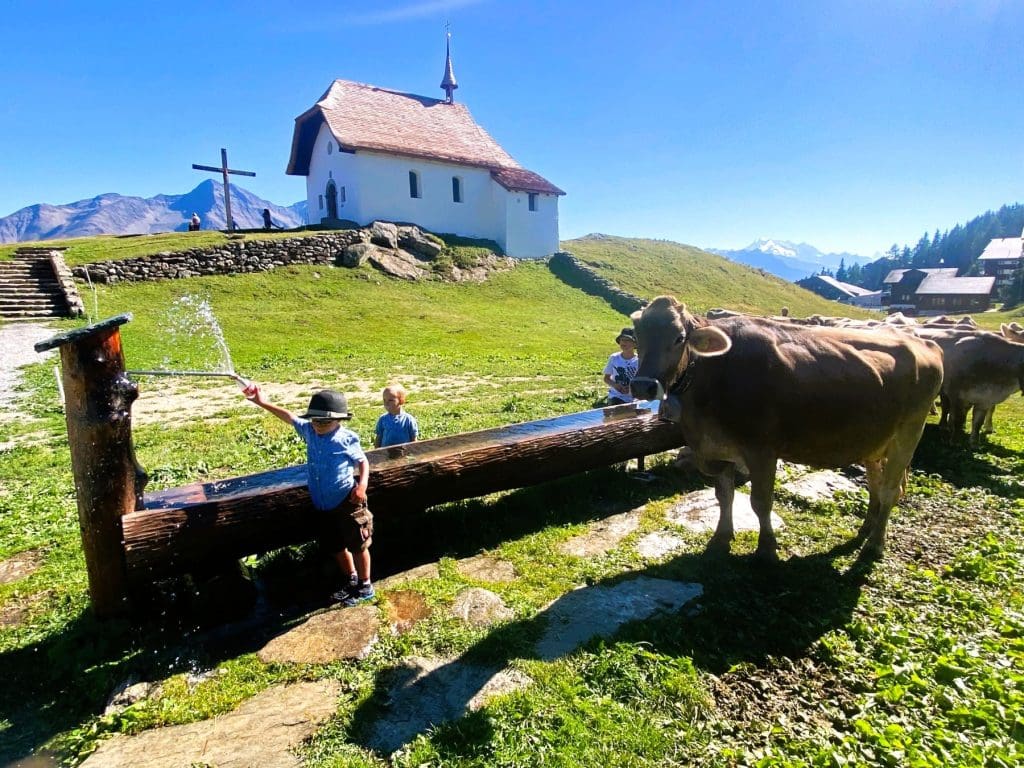
Haute-Nendaz
I bid adieu to Jasmine at Brig to continue my journey to Leukerbad. After my lunch at Gemmi Lodge, I continue by bus to Leuk from where I take the train to Sion and finally another bus to Haute-Nendaz.
This might seem a bit of a trek, but travelling on public transport in Switzerland is a breeze. The bus ride from Leukerbad to Leuk was particularly scenic as well as entertaining when we became briefly invaded by a group of schoolkids.
However, as the temperatures hover around the high twenties, I am pleased to arrive at my hotel the Nendaz 4 Vallées & Spa, an excellent Valais hotel, where I spent the next hour lazing around the most amazing spa with the now expected spectacular views.
I am met at the hotel by Émilie Mariéthoz from the Nendaz tourism department. Her plan was for us to eat raclette on a bisse. These are historic irrigation channels built in the Valais region to convey water from the mountains to the towns and villages. The network of bisses stretches for more than 100 kilometres. Often, they were cut into the side of rocks.
However, this has to be cancelled due to the risk of fire. Instead, Émilie takes me to the excellent Les Bisses restaurant which has a very local and informal ambience and where we have some excellent trout as well as the local Serac cheese which I believe is something of an acquired taste.
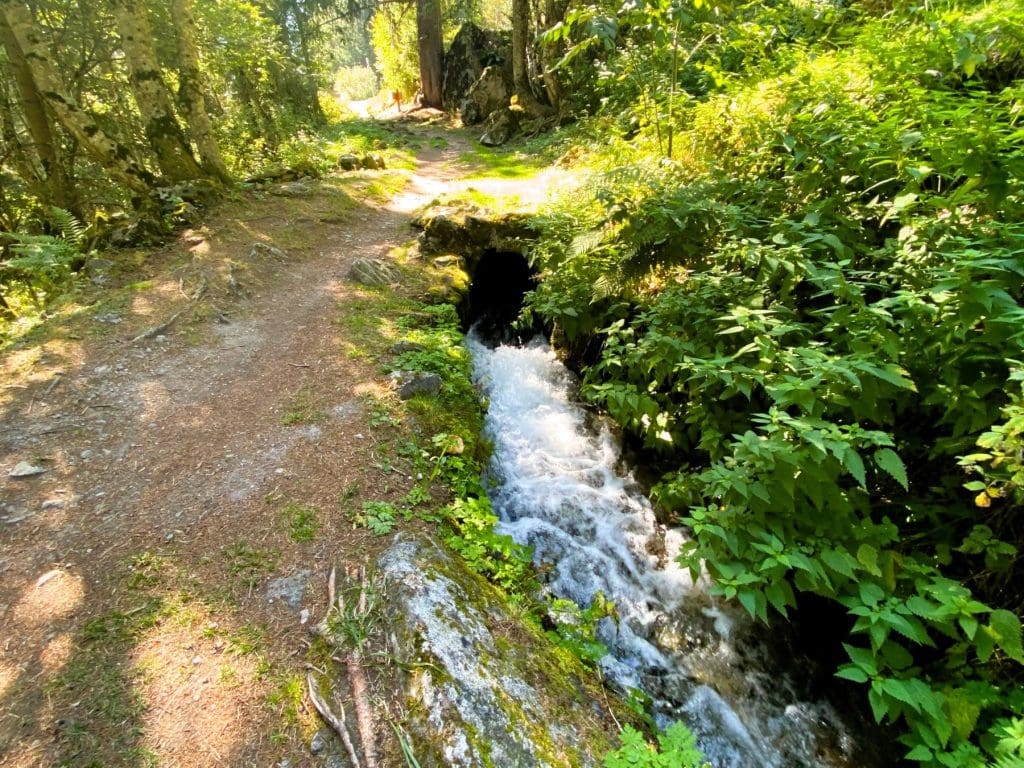
The following morning, we walk along the bisse where we were supposed to have the raclette. It is most relaxing to stroll alongside the flowing water especially in the shade of the trees. Unfortunately, many of the spruce trees are dying victims of the bark beetle and climate change as I had also discovered in my earlier visit to Austria.
Cleuson Dam
The final part of my trail through the waters of Valais takes me to the top of Cleuson Dam. Built between 1947 and 1950, it is part of the hydroelectric complex of Grand Dixence and supplies the electricity for the region as well as providing power to other parts of Switzerland.
The dam is 87 metres high and 420 metres long. You can get the free shuttle bus from Nendaz to the car park where you commence your walk, which is quite steep and takes around an hour. The forest is most tranquil, and the beautiful aquamarine colour of Lake Cleuson and the great views down to the valley below reward my exertion.
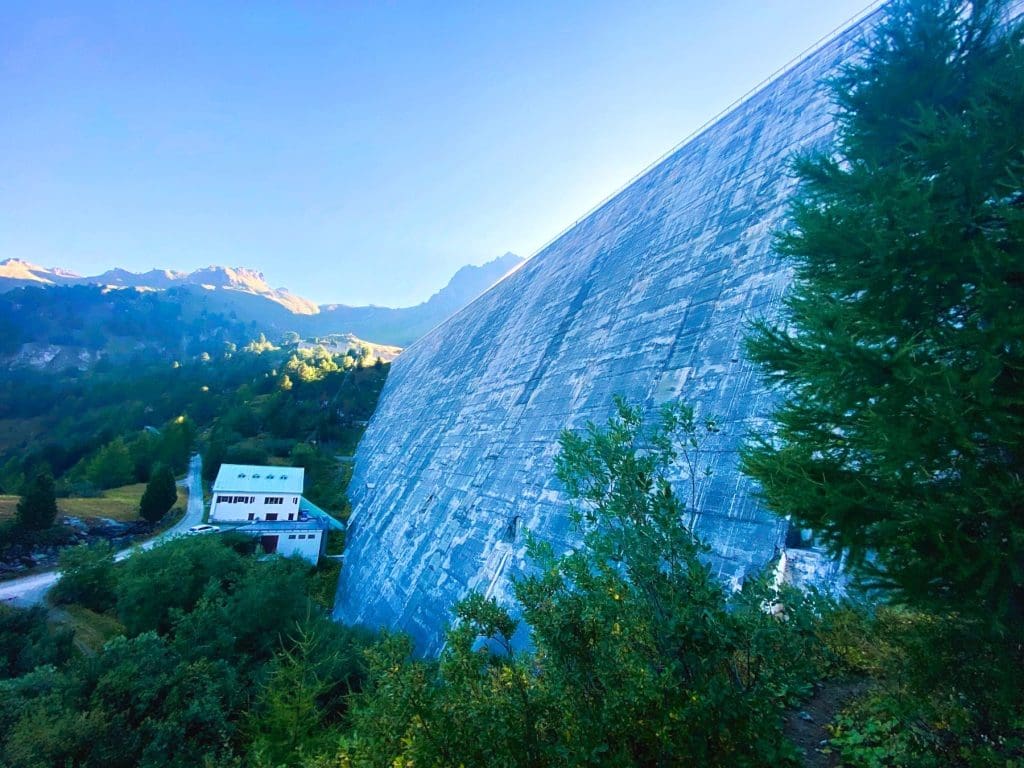 The fit can carry on their walk around the dam up to a refuge on a hill in the distance or to a nearby bisse which is the highest in the region.
The fit can carry on their walk around the dam up to a refuge on a hill in the distance or to a nearby bisse which is the highest in the region.
This is a wonderful place to conclude my journey tracing the waters of Valais, immersed not just in outstanding beauty but also the enormous power of the region’s water. Émilie recognises the sound of some marmots on our descent. Apparently, these animals whistle to their neighbours when danger is approaching. Perhaps they too know about the perils of climate change? Or maybe it is just the inherent danger of man?
Valais Switzerland Photo Gallery
Swiss Travel System
When visiting Valais, we advise you purchase a Swiss Travel Pass offers which offers unlimited travel across Switzerland’s rail, bus and boat network. This pass covers scenic routes, as well as local trams and buses in 90 towns and cities, and includes a Swiss Museum Pass that allows you free entrance to 500 museums and exhibitions. Visit: www.swisstravelsystem.co.uk.
Aletsch Arena Sustainability
To learn more about the Aletsch Arena’s sustainability efforts, click here https://www.aletscharena.ch/en/aletsch-arena/sustainability.
Things To Do in Valais Switzerland
To discover what you can do in Valais, please click here.
